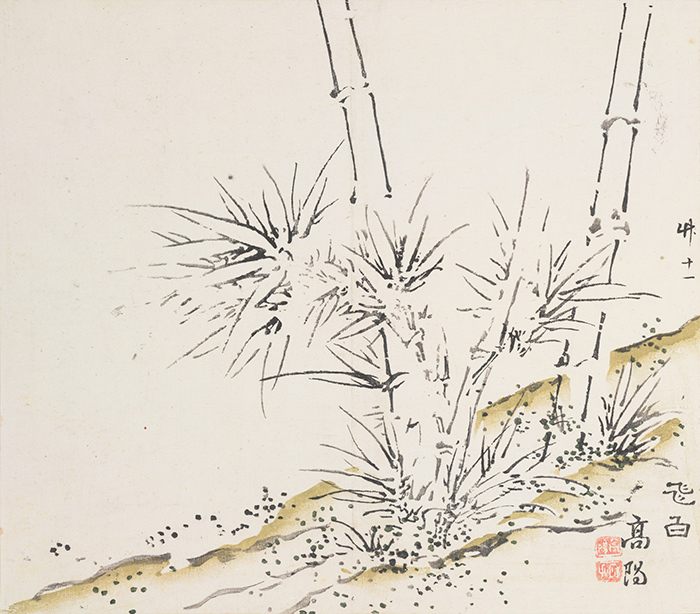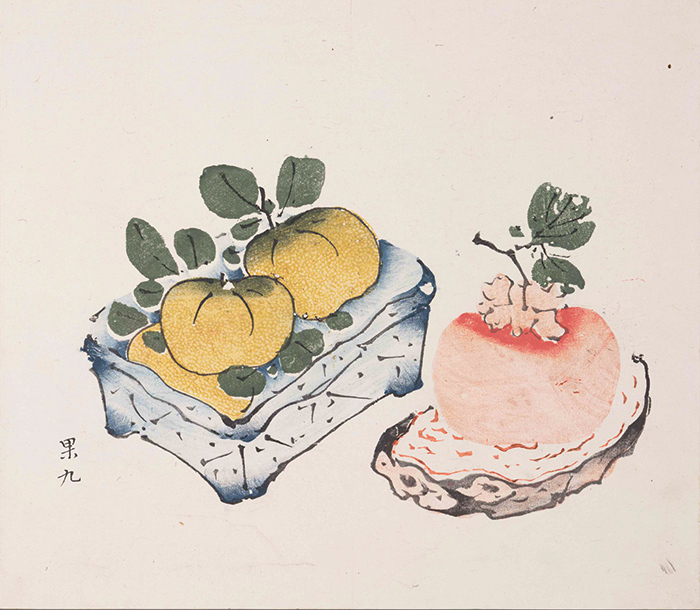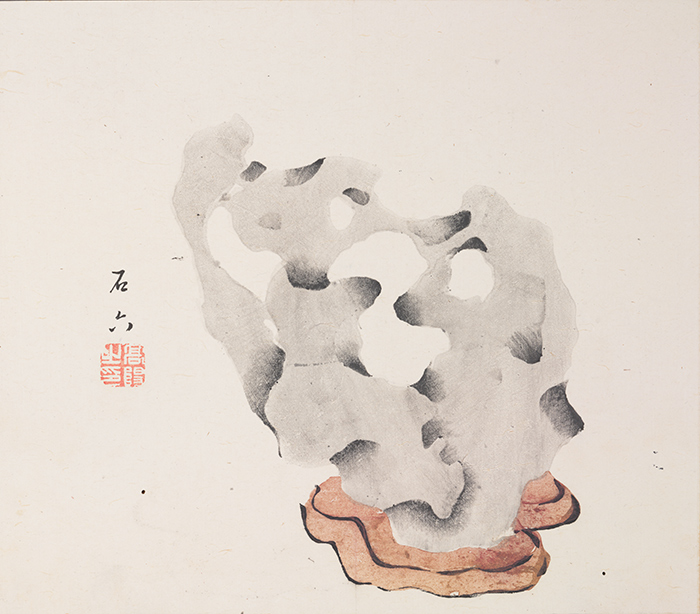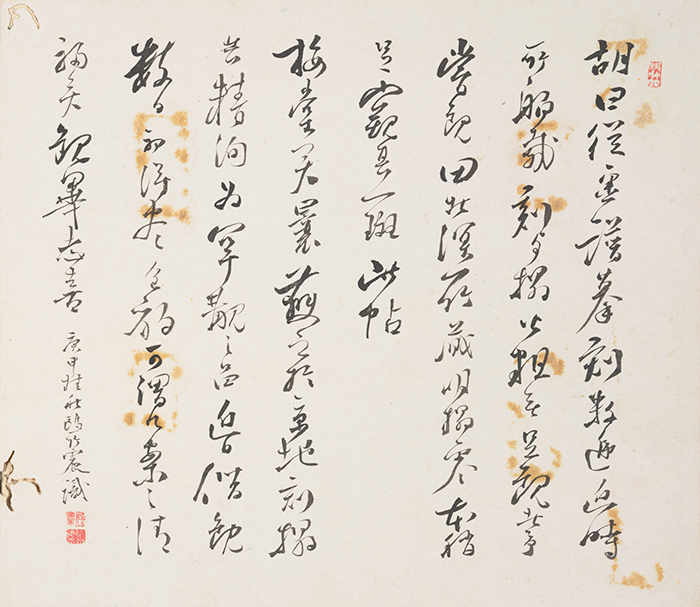Posted on Thu., Sept. 15, 2016 by

Detail of bird eating fruit, Painting 2, Ten Bamboo Studio Manual of Calligraphy and Painting, ca. 1633–1703, woodblock-printed book mounted as album leaves, ink and colors on paper. The Huntington Library, Art Collections, and Botanical Gardens.
Sometimes an object comes along that has so many ties to an institution’s collecting areas, it’s hard for curators to pass it up. That’s what happened in 2014, when The Huntington acquired the Ten Bamboo Studio Manual of Calligraphy and Painting 十竹齋書畫譜 (ca. 1633–1703), a remarkable example of early Chinese color woodblock printing, with poems and images focused on gardens.
Visitors can view the Ten Bamboo Studio Manual for the first time in the exhibition “Gardens, Art, and Commerce in Chinese Woodblock Prints,” on display in the MaryLou and George Boone Gallery from Sept. 17, 2016 to Jan. 9, 2017.

Artist Gao Yang created this striking image of bamboo, “Flying White.” Bamboo 11, Ten Bamboo Studio Manual of Calligraphy and Painting, ca. 1633–1703, woodblock-printed book mounted as album leaves, ink and colors on paper. The Huntington Library, Art Collections, and Botanical Gardens.
This extraordinary work contains 139 pages of poetry and 185 hand-printed color woodblock designs. The delicate calligraphy is accompanied by exquisite color images of pine trees, bamboo leaves, garden rocks, birds, and a delectable selection of fruits featuring grapes, tangerines, loquats, lychees, and persimmons.
The Huntington was drawn to the Ten Bamboo Studio Manual because it related to all three of its collecting areas—library, art, and gardens—and it provided the historical background for The Huntington’s Suzhou-style Chinese Garden, the Garden of Flowing Fragrance 流芳園.

Lines of verse from Mo Jian describe the ways in which the flecks of ink from a dry brush, typically referred to as “flying white,” capture bamboo leaves. His words begin: “Sloughing off both vibrant green and darker hue, / Its delicate leaves capture the reflections of the Xiang River.” Bamboo 11, Ten Bamboo Studio Manual of Calligraphy and Painting, ca. 1633–1703, woodblock-printed book mounted as album leaves, ink and colors on paper. The Huntington Library, Art Collections, and Botanical Gardens.
To understand this context, it’s helpful to consider the time and place where the Ten Bamboo Studio Manual and other works in this exhibition were created.
During the late Ming to early Qing period (late 16th to 19th century), commerce in the Yangzi River Delta linked to the salt, rice, and silk industries generated wealth that led to higher levels of literacy and education. That, in turn, fueled an appetite for printed works and the building of garden estates, among other things.
Suzhou, a city about 60 miles northwest of Shanghai, was developing a reputation for its stunning classical gardens. Scholars used rocks, hills, and water to construct landscapes that imitated nature and then carefully positioned pavilions and pagodas within the design. The Huntington's Garden of Flowing Fragrance is styled after these gardens.

Persimmon and tangerines, Fruit 9, Ten Bamboo Studio Manual of Calligraphy and Painting, ca. 1633–1703, woodblock-printed book mounted as album leaves, ink and colors on paper. The Huntington Library, Art Collections, and Botanical Gardens.
Just 150 miles northwest of Suzhou lay Nanjing, China’s secondary capital and the site of the Ten Bamboo Studio, a printing house known for the superior quality of its publications. It was here, in 1619, that its founder, Hu Zhengyan, a well-connected artist and calligrapher, began work on the Ten Bamboo Studio Manual of Calligraphy and Painting. Hu would take 14 years to complete the project, hiring more than a hundred artists and artisans, including painters, calligraphers, woodblock carvers, and printers.
The result was spectacular. Not just a how-to painting manual—such as the Canon of Paintings and the later Mustard Seed Garden Manual of Painting (both in the exhibition)—the Ten Bamboo Studio Manual was an aesthetic indulgence, a luxury item that elevated printing to an art form.
The Ten Bamboo Studio used the doubanor “assembled block” method to create images, a technique that involves applying each color with a block just large enough to accommodate that part of the design. By wiping away some of the ink and printing the image several times, the artists could layer the colors, achieving a subtle shading that resembled watercolor painting.

Rock on stand, Rock 6, Ten Bamboo Studio Manual of Calligraphy and Painting, ca. 1633–1703, woodblock-printed book mounted as album leaves, ink and colors on paper. The Huntington Library, Art Collections, and Botanical Gardens.
The manual was a phenomenal success, remaining continuously in print through several editions up until the 19th century. It attracted strong interest among literati in China and elsewhere, especially in Japan.
Indeed, The Huntington’s copy—one of the earliest editions—made its way to Japan sometime in the 1760s. There, the original 16 volumes were disbound and reorganized into three books, labeled Heaven 天, Earth 地, and Man 人. Inside are five inscriptions by renowned Japanese artists, attesting to their high regard for the manual.
The convergence of gardens, art, and commerce captured the imagination of the literary merchant class in China—and in Japan. It was also a winning combination for Henry E. Huntington. Today’s visitors have an opportunity to observe this same phenomenon by viewing some rare and beautiful color woodblock prints that were produced in a very different time and place.

This postscript to the “Heaven” album, 1860, by an unidentified Japanese artist writing in classical Chinese, reads in part, “This manual . . . is exquisitely carved and printed and is truly a rare specimen. Recently, I borrowed it for viewing over the course of several days, thus finally being able to observe it in full. This is truly a pure blessing for my studio. Having viewed the work, I register my joy.” Ten Bamboo Studio Manual of Calligraphy and Painting, ca. 1633–1703, woodblock-printed book mounted as album leaves, ink and colors on paper. The Huntington Library, Art Collections, and Botanical Gardens.
iPads will make it possible to closely examine digital versions of two of the exhibition’s works: the Ten Bamboo Studio Manual and Illustrations of the Garden Scenery of the Hall of Encircling Jade (1602–1605), which shows in great detail the private garden of Wang Tingna (ca. 1569–after 1628), a successful playwright, merchant, and publisher from Huizhou, China.
“Gardens, Art, and Commerce in Chinese Woodblock Prints” is a major international loan exhibition and runs from Sept. 17, 2016, through Jan. 9, 2017.
Diana W. Thompson is senior writer for the office of communications and marketing at The Huntington.